Health & Education
We all want the best care possible for our horses. The Heath & Education section covers both Learning Institutions, Organizations as well as many sources for equine assistance including Veterinarians and Farriers.
For those who want a to formally study horses, the Education section includes College Riding, Equine Studies, and Veterinary Schools. Learn about the wide variety of horses in the Horse Breeds section. Supplements and Treatments Therapy are also included in the section.
Everyone can learn from Fine Art and there are some specialty Museums that might surprise you.
Horses as a therapy partner enrich the lives of the disabled. These facilities are listed in our Therapeutic Riding section. To help children and young adults build confidence and grow emotionally, please see the resources available on the Youth Outreach page.
Looking for a place to keep your horse? You can find it in the Horse Boarding section. Traveling? Find a Shipping company or Horse Sitting service if your horse is staying home!
Want to stay up to date with the latest training clinics or professional conferences? Take a look at our Calendar of Events for Health & Education for the dates and locations of upcoming events.
Do we need to add more? Please use the useful feedback link and let us know!
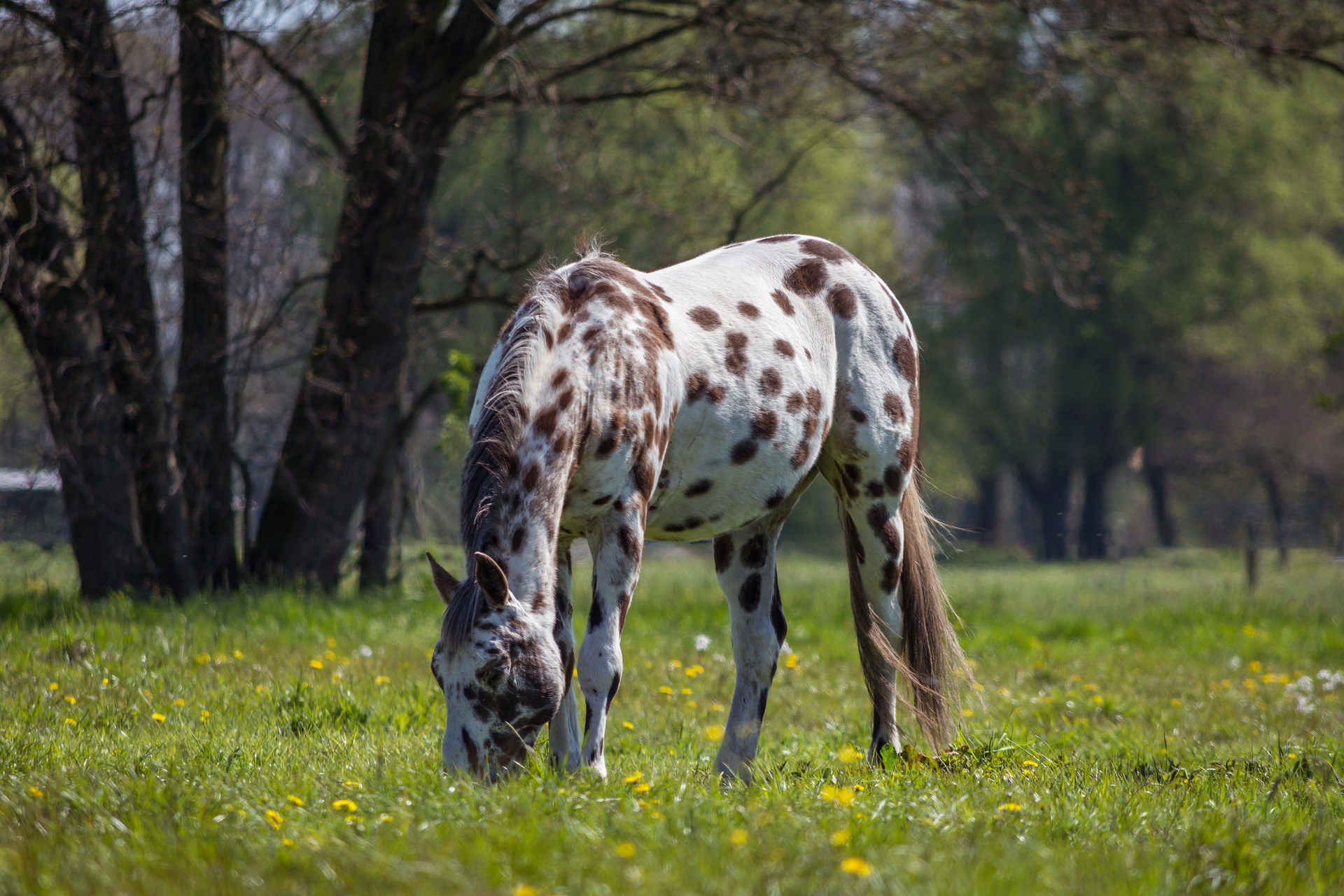
by Eleanor M. Kellon, VMD
Equines with uncontrolled Primary Pars Intermedia Dysfunction (PPID) are often more prone to high parasite burdens related to immunosuppression from the disease, so diligent deworming — and control of ACTH — is essential. The fecal egg count (FEC) has become the method of choice for determining when to deworm a horse but there are many shortcomings.
Most labs do simple flotations, which means manure is mixed with a concentrated sugar or salt solution then allowed to sit. The eggs will float up and attach to a microscope slide at the top of the container.
The first problem with FECs is they were designed to reduce contamination of the environment, not to make sure the individual is parasite free. Eggs passed in the feces is how parasites spread from horse to horse. However, only adults pass eggs so you know nothing about other life stages, or parasites not laying eggs, or eggs not mixed evenly into the manure.
Any of the following can be undetectable or easily missed:
- Immature or tissue forms of parasites
- Tapeworms
- Bots
- Pinworms
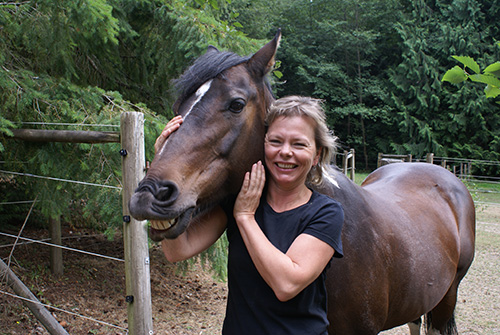
Carole Herder, President of Cavallo Horse & Rider, shares her thoughts.
Q: Carole, you often talk about leaning on your horses during times of stress. The constant news about COVID has me worried and downright fatigued. What’s the best way that you have found for horses to help during this ongoing pandemic?
A: Horses provide a quiet connection to nature and help us all connect and quiet our minds. We live in the country and enjoy a rural setting. We all have our animals to keep us from feeling too much isolation. They are often the best companions anyway. During this time of pandemic, people are out riding their horses, and they are calling us for advice about how to keep their horses moving and feeling great.
Pandemic Panic
Unfortunately, not everyone is doing as well. For example, my neighbor is negatively affected by this pandemic. By the news, the fear, and the anxiety around COVID. She's not alone. Constantly judging the correct distancing and checking to see whether people are wearing masks has many people upset.
These folks are placing their frame-of-reference on the external forces around them and forgetting to nurture their own internal states. They're letting the news run the show. My friend has a hard time looking inward and is continuously being distracted by the media. She lost her horses last year, and I now see how important they were to her happiness. They helped her focus, be quiet and connect with nature. That's what horses do.
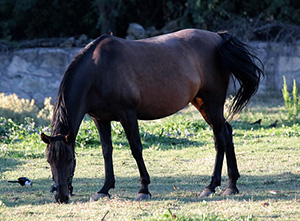
The pregnant mare has the same basic needs for water, nutrients and exercise, but with different targets.
The calories are the easy part. If you have a good quality hay (DE at least 0.9 Mcal/lb on hay analysis) she will need to eat only about 19 lb of hay/day in her 5th month, up to 24 lbs in the last month if her prepregnancy weight was 1100 lbs - and proportionately less or more if she is below or above that weight. This is definitely a reasonable consumption. If she won't eat that much, supplement her with a balanced commercial feed at the rate of 1 lb of feed for every 2.5 lbs of hay below her target intake.
Protein may be more problematic. She can still meet protein needs if the hay is at least 11% protein. This is possible but by no means guaranteed. If your hay is 8% protein instead of 11%, it is lacking 14 grams of protein per pound. For 20 lbs of hay that's about 280 g of protein.
If you are feeding grain instead of hay for part of the ration, there is also a protein deficiency. One pound of grain = approximately the calories of 2.5 pounds of hay. If the grain is 14% protein it supplies 64 g of protein. Even an 8% protein hay yields 91 g of protein in 2.5 pounds and at 11% it is 125 g compared to the 64 g in the grain.
The body makes proteins by stringing together amino acids. Essential amino acids are those that need to be adequate in the diet because the horse cannot make them. Lysine is the most important in pregnancy and supplementing at least 10 g/day is advisable, either as part of a protein supplement or separately if not supplementing protein.

State Line Tack® is proud to bring you the inside scoop on riding programs that are working hard to bring access to horses to kids of all ages. This month's spotlight is on Ebony Horsewomen.
What is Ebony Horsewomen?
Founded by Patricia E. Kelly in 1984, Ebony Horsewomen, Inc. was initially conceived as a cultural enrichment organization. Made up of African American female equestrians who operated community programs and rode in rodeos, EHI has morphed over the years into a comprehensive equine educational and therapy program.
A Grocer and a Horse and Wagon
In the early 1950s, Patricia’s parents moved to a new neighborhood. There, their neighbor was a Jewish grocer who owned a horse and wagon for his business. Mr. Fisher, the grocer, allowed Patricia to groom and ride the horse until its unfortunate death 2 years later in a fire. However, this short timespan was long enough to ingrain her desire for the equestrian lifestyle. Growing up as a horse crazy youth, many people thought it strange for a colored girl
to fancy herself a cowgirl, with no visible representation to inspire her to it.
Marine Corps, a Men’s Group and New Beginnings:
Patricia joined the USMC after high school, and after she left the Corps, she yearned to rejoin the equestrian community. She connected with a men’s group in Hartford, CT - the Ebony Horsemen - a noted and long-standing group of African American horsemen.
Based on her experience with that group, Patricia and her youngest daughter organized the Ebony Horsewomen, which immediately started attracting skilled equestrians from Alaska to Maine, women who appeared in parades, rodeos, and horse shows all across America. They became the first African American all-female equestrian organization to be invited to participate in the Tournament of Roses Parade in 1990, and the State of Connecticut Legislature proclaimed them as Goodwill Ambassadors.
Read more: Equestrian Diversity Project Spotlight: Ebony Horsewomen
This video is Part 1 of a 3-part series that takes viewers on a journey through the horse’s digestive tract. Parts 2 and 3 will be released in Equine Guelph’s monthly communications in November and December. You can sign up here: https://www.equineguelph.ca/news/signup.php to catch their release.
These videos feature Equine Guelph's director, Gayle Ecker, and a rising standardbred star named Jack. Make sure to tune in as we learn what the horse’s digestive system looks like, how big it actually is, what makes it unique and how nutrition and management strategies can keep it healthy and happy!

Nashville, Tennessee — Today Animal Wellness Action (AWA), the Animal Wellness Foundation (AWF), the Center for a Humane Economy, Horses for Life Foundation, American Horse Protection Society, and key stakeholders in the Tennessee Walking Horse industry announced a historic effort that seeks to end soring, protect the Tennessee Walking Horse and the breed, and preserve a show horse that the public will applaud. These key players have agreed to support legislation to ban action devices and tail braces, to dramatically reduce the size of the shoe, and to establish additional penalties for horse soring.
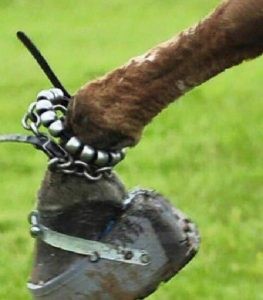
The Horse Protection Act (HPA) of 1970 authored by the late U.S. Senators Joe Tydings, D-MD, and Howard Baker, R-Tenn., was enacted to stamp out soring but left loopholes that have allowed the practice to persist. Over the past eight years more than 20 pieces of legislation and amendments to the HPA have been introduced in the U.S. House of Representatives and U.S. Senate geared at combating the painful practices of soring – the intentional infliction of pain to horses’ feet to achieve an unnatural high-step that trainers utilize to cheat and avert proper training practices. Not a single measure has been enacted, leaving a 50-year-old statute to govern management of regulated horse shows.
The U.S. Senator Joseph D. Tydings Memorial Prevent All Soring Tactics (PAST) Act, H.R. 693/ S. 1007 (named only Prevent All Soring Tactics in the Senate) passed the U.S. House in July 2019 but is stalled in the U.S. Senate, with no reasonable prospects of that circumstance changing. This is the ninth rendition of the bill since 2012, and the Senate has never taken up the bill on the floor. The Horse Protection Amendments Act, H.R. 1157/S. 1455, introduced on seven occasions in either the House or Senate, and supported by the Tennessee Walking Horse industry, has also not advanced. Even attempts to finalize regulations to end soring have long-failed at every turn.
“Bitter political adversaries have come together to break the logjam in Congress and put the nation on a path to end horse soring,” said Wayne Pacelle, president of Animal Wellness Action, and the Center for a Humane Economy. “If enacted, this deal will end the political stalemate in Congress and take the pain out of Walking horse shows throughout the South.”
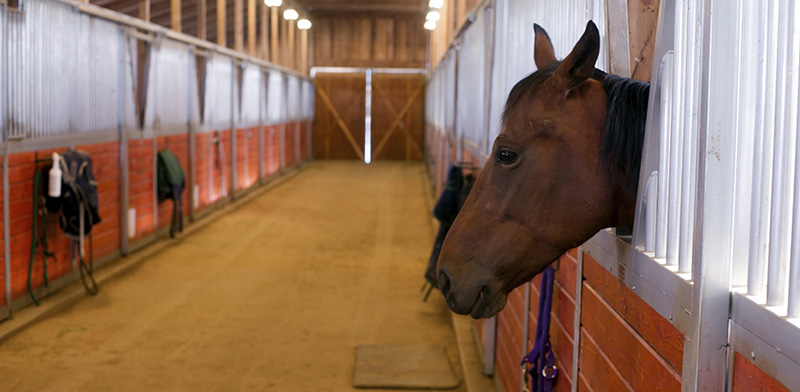
When the winds are up and temperatures drop we want our horses to be comfortable and protected. Nestling into a cozy stable may seem like a good solution but there are health risks lurking in a tightly closed up barn.
That cozy barn may not be best for lung health.
Horses actually breathe easier in cold, dry air. However, this winter advantage is lost when horses are confined to a poorly ventilated barn where humidity and particulate matter in the air is high.
A variety of airborne substances have been implicated in causing lung irritation. Ammonia from bacterial breakdown of urea in urine is a well documented lung irritant in a variety of species. "Organic dust" is also an offender. This includes microscopic particulate matter from mites, plant material (e.g. beta-glucans), feces, bacteria and their products (endotoxin) and fungal spores.
Keeping stalls clean and the building well ventilated are the first steps in reducing exposure. Using wood chips or synthetic bedding (e.g. paper based) reduces plant and fungal matter but must be used in all the stalls. Horses are also exposed when hay or straw are stored in the same building, even in a loft. Horses with signs of respiratory tract irritation should have their hay and bucket fed meals thoroughly wet down. Always strive to remove horses from the barn when stalls are being cleaned and aisles swept.
Read more: Air Quality in the Barn - That Cozy Barn May Not Be Best for Lung Health
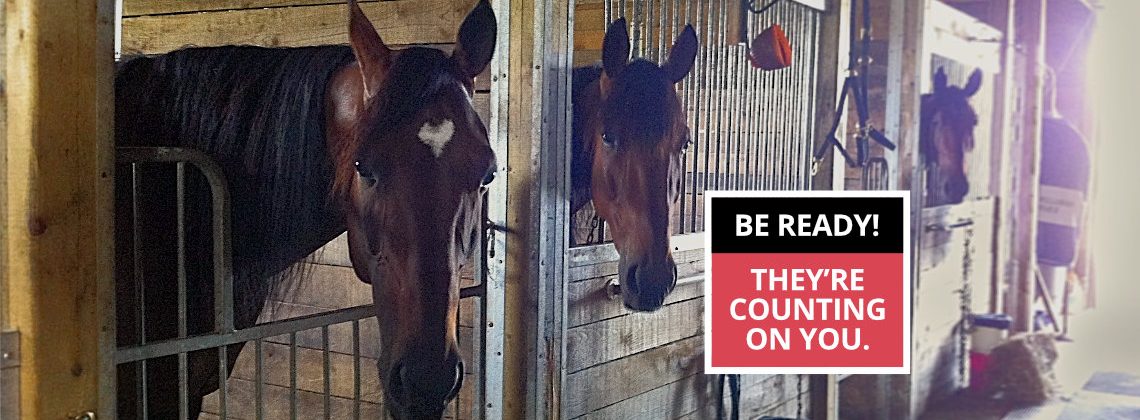
Waiting until the wildfire approaches dangerously close is no time to draw up a disaster preparedness plan. Learning the hazards of storing hay is too late after the barn is reduced to ashes and all is lost. It is not a scenario that one fathoms will ever happen to them, until it does. Equine Guelph’s October healthcare tool of the month is the free, interactive Barn Fire Prevention tool. This is a great place to start before signing up for the invaluable HorsePortal.ca Fire & Emergency Preparedness one-week short online course set to begin Oct 5, 2020.
Returning expert guest speaker Rebecca Gimenez-Husted will be available all week to provide insight and answer all your burning questions. Gimenez has travelled the world providing training in Technical Large Animal Rescue Techniques (TLAER website) and has published numerous critiques, techniques and journal articles on the topic. Rebecca edited the only textbook available to the fire service and veterinarians on technical rescue of large animals.
As a volunteer firefighter in Gray, GA, Rebecca is doing R&D work with University of Edinburgh (UK), EKU (KY) and several veterinary schools. A past Logistics Officer for FEMA’s Veterinary Medical Assistance Team (VMAT -2), decorated combat veteran and a Major in the US Army Reserves (retired); Rebecca offers a wealth of information and is active in various organizations related to disaster preparedness.
Read more: Practice Preparedness and Prevention - Resources on Barn Fire Prevention

Yes, it's what you think it is! Receiving fecal material from a healthy donor is in the news for people these days. [click on "download PDF" to get the complete article]. It has been approved by the FDA as a method to help restore normal gut flora in situations where there is an overgrowth of harmful organisms like Clostridia.
There is now a company offering fecal transplants for dogs and cats - AnimalBiome. In humans, the prepared fecal transplant is usually deposited directly into the colon to avoid inactivation in the stomach. For the pets, enteric coated capsules are used to dose orally. This is easy to administer to a dog or cat by hiding the capsule inside a bite of meat or butter because these animals will swallow whole without chewing.
As with humans, donors are screened for general and digestive health. Their feces are also tested for harmful bacteria and parasites.
Oral delivery dates back to 4th Century China in people and 17th Century Italy in animals. Transplantation of rumen contents is a well established practice in bovine medicine. It has also been used sporadically in horses. I remember straining fluid from the contents of the cecum of recently deceased horses for administration by stomach tube to horses.
- I Have the Wrong Horse: Now What?
- Gratitude & Horses: Healing the Cracked Places
- From the Research Farm to Your Feed Room: Applying Study Results to Improve KER EO-3
- Neuromuscular Support Nutrients
- The Roadmap to PTSD in Horses
- Is Your Horse Happy and Comfortable? Find Out with This Simple Body Exploration
- Appaloosa - The Most Beautiful Horse Breed in the World
- Stress and Your Horse's Brain
- Horse Training Power Tip: Loading Difficult Horses Into Trailers
- Electrolyte Problems in Endurance Horses
- Electrolyte Problems in Endurance Horses
- U.S. Rep. Steve Cohen Ushers Horse Transportation Safety Act to Passage
- A Vet’s Guidance for Saving Horses in Need, Plus Training Your Eye to Nail the Distance
- Grazing the Metabolic Horse
- Disaster Preparedness
- Need Help Reopening Your Equine Business Amidst Covid-19? Barton Rodgers TempDefend™ Sensor Solution is Your Answer!
- Why I Did the Mustang Makeover—and Why I’d Do It Again
- Improve the Horse’s Balance, Movement, and Self-Carriage with These Easy Tail Exercises
- Q&A: Managing Arthritis in Horses
- The Benefits of Riding to Music












































